Abstract
A prospective study was performed to assess the use of plasma measurement of tumour necrosis factor (TNF), lymphotoxin alpha (LT alpha) and their soluble receptors (p55 and p75) for prognostic risk assignment in 61 patients with Hodgkin's disease. Plasma levels of TNF, p55 and p75, but not of LT alpha, were higher in Hodgkin's disease patients than in healthy controls. Plasma levels of TNF, p55 and p75 were associated with several prognostic factors for Hodgkin's disease, including those related to the host (age, performance status) and to the tumour (disease stage, extranodal site involvement, bulky tumour, serum levels of LDH and beta2-microglobulin, histology). Elevated plasma levels of TNF, p55 and p75 were also associated with several parameters reflecting an immune activation, including the presence of B symptoms, elevated serum levels of gammaglobulins, alkaline phosphatase and fibrinogen, as well as peripheral monocytosis, anaemia and low serum albumin levels. Finally, elevated TNF ligand receptor plasma markers were associated with a lower incidence of complete response to therapy and predicted shorter free-from-progression survival and overall survival of the patients. These results indicate that the plasma levels of TNF and its soluble receptors correlate with clinical features and outcome of patients with Hodgkin's disease.
Full text
PDF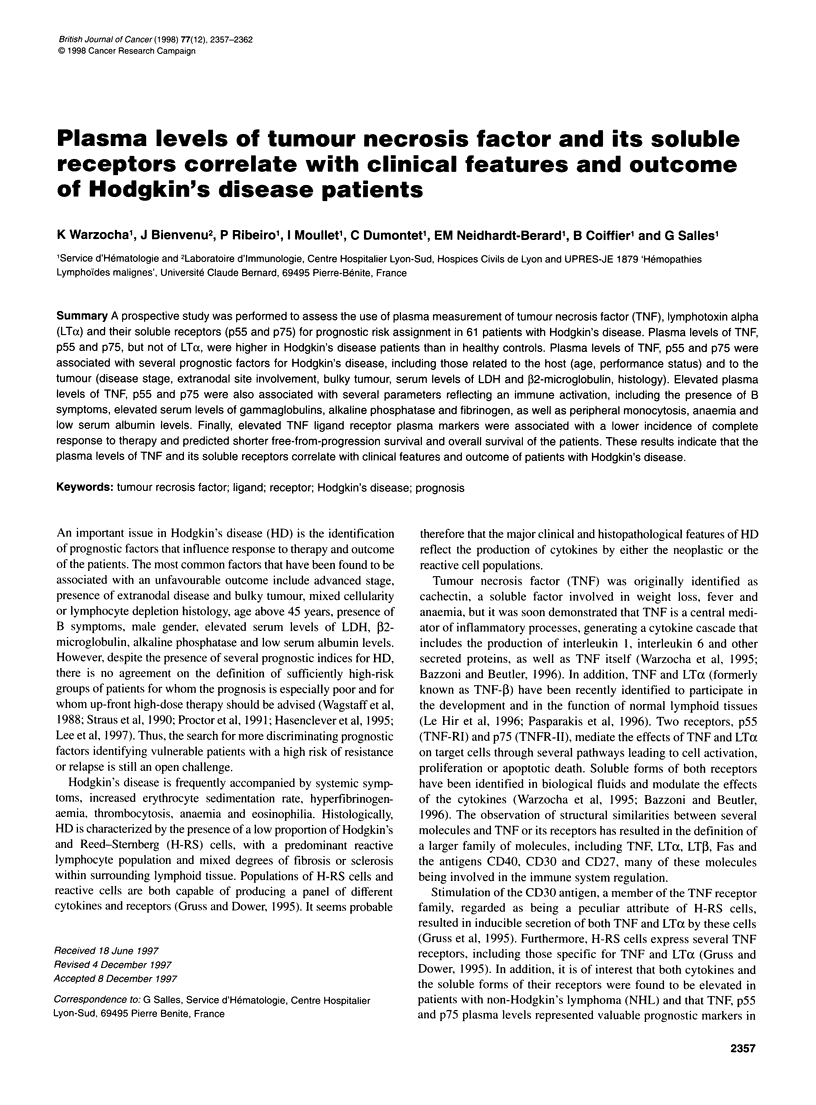
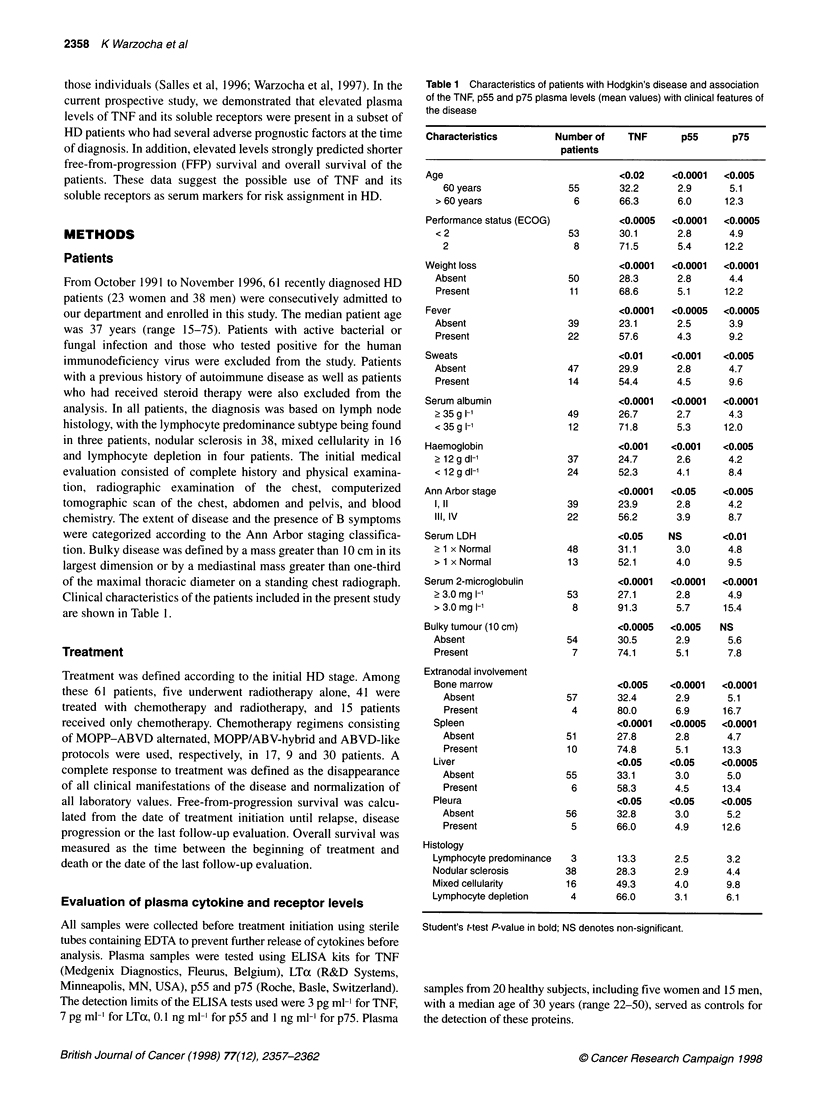
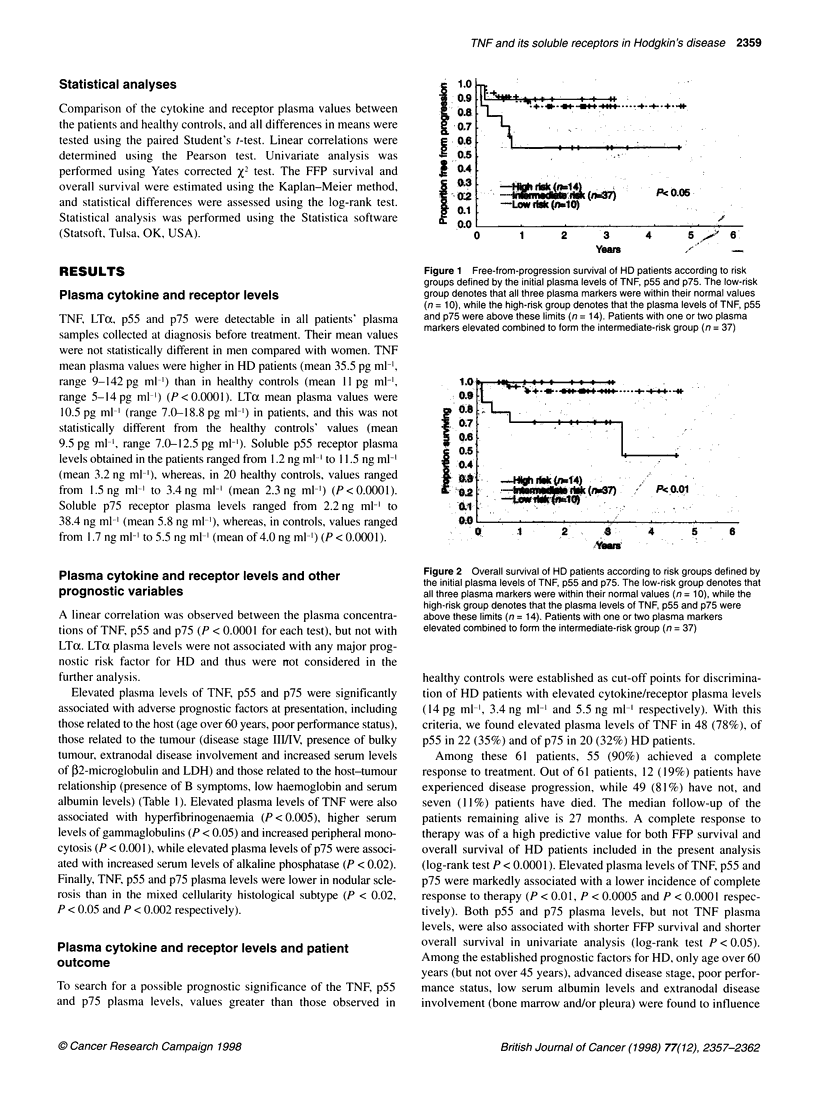
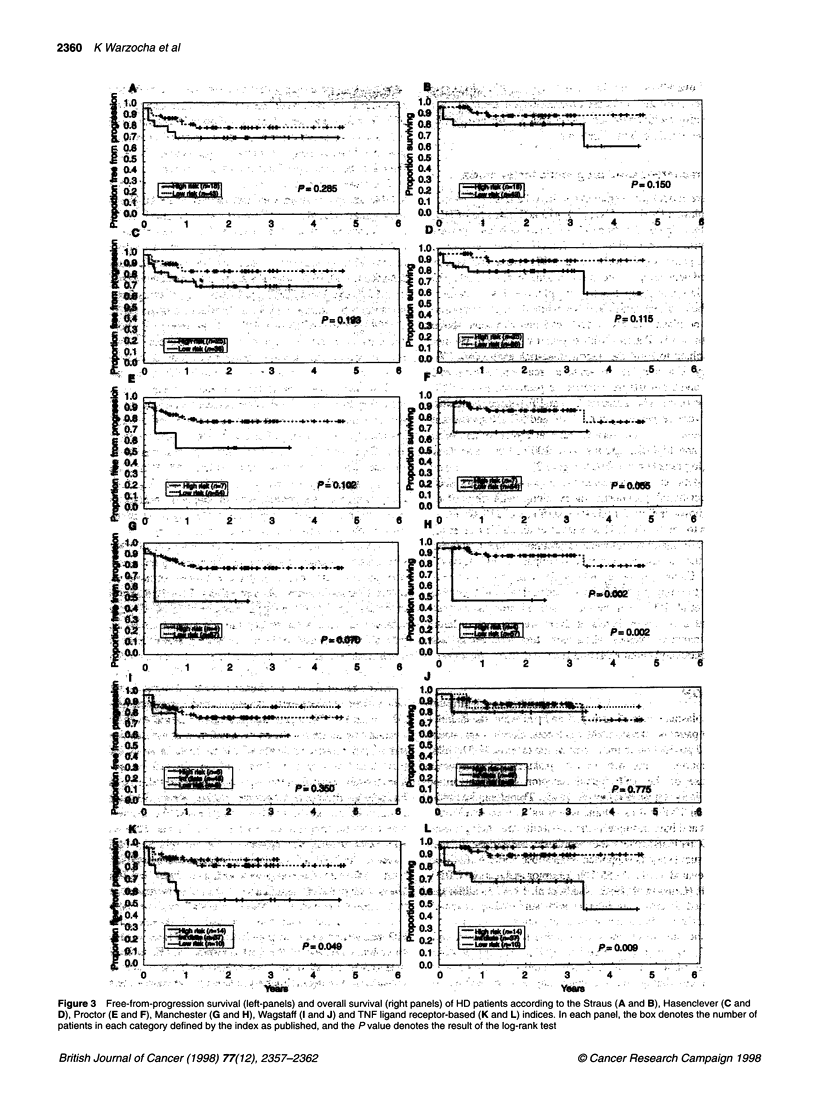
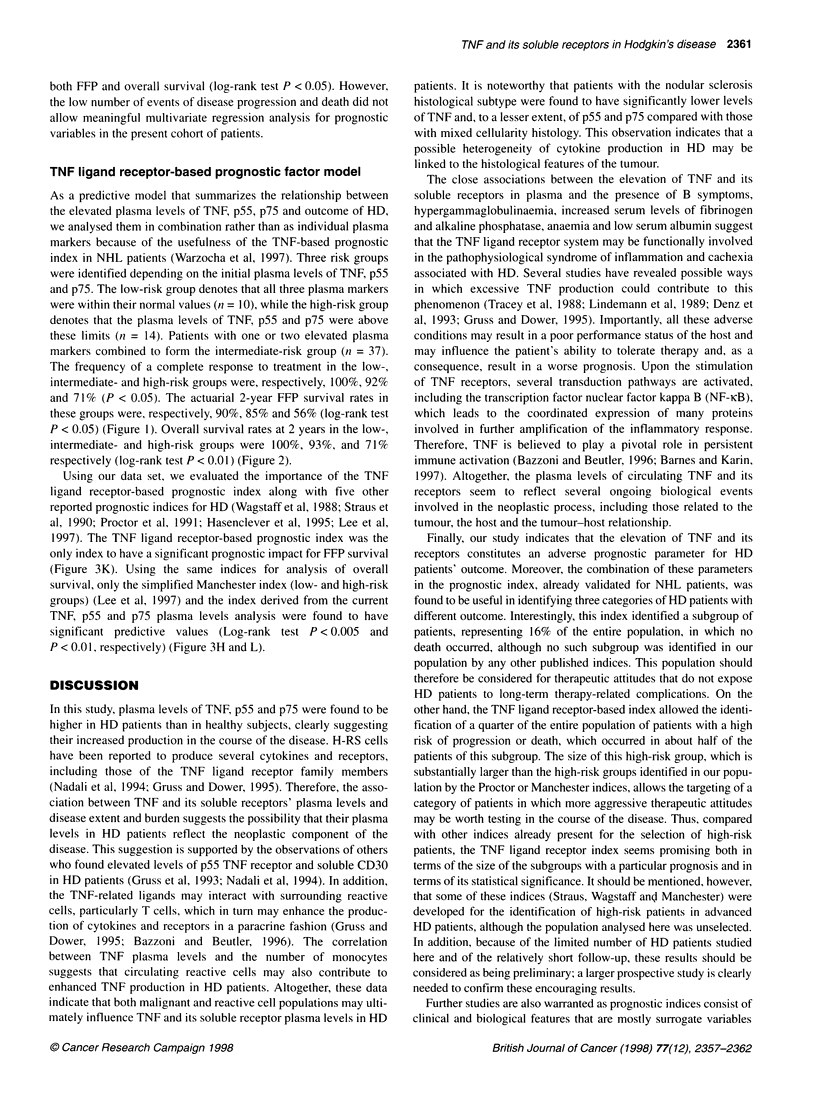
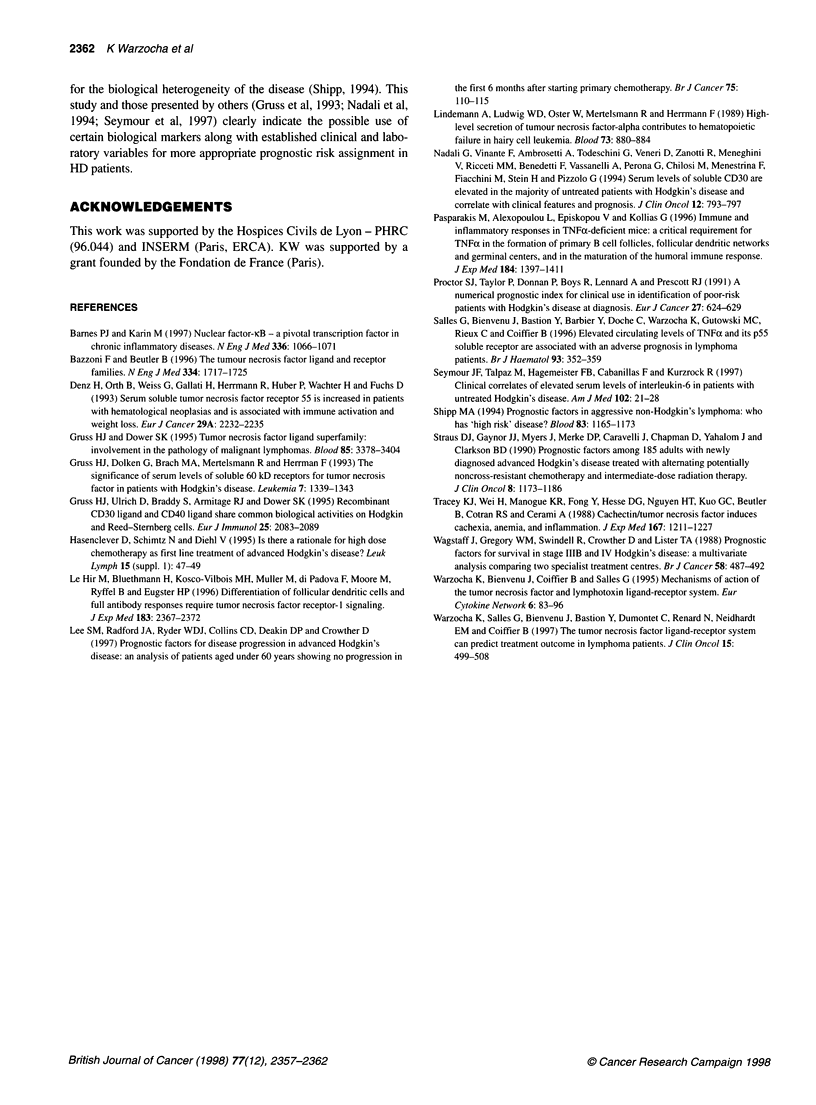
Selected References
These references are in PubMed. This may not be the complete list of references from this article.
- Barnes P. J., Karin M. Nuclear factor-kappaB: a pivotal transcription factor in chronic inflammatory diseases. N Engl J Med. 1997 Apr 10;336(15):1066–1071. doi: 10.1056/NEJM199704103361506. [DOI] [PubMed] [Google Scholar]
- Bazzoni F., Beutler B. The tumor necrosis factor ligand and receptor families. N Engl J Med. 1996 Jun 27;334(26):1717–1725. doi: 10.1056/NEJM199606273342607. [DOI] [PubMed] [Google Scholar]
- Denz H., Orth B., Weiss G., Gallati H., Herrmann R., Huber P., Wachter H., Fuchs D. Serum soluble tumour necrosis factor receptor 55 is increased in patients with haematological neoplasias and is associated with immune activation and weight loss. Eur J Cancer. 1993;29A(16):2232–2235. doi: 10.1016/0959-8049(93)90212-x. [DOI] [PubMed] [Google Scholar]
- Gruss H. J., Dower S. K. Tumor necrosis factor ligand superfamily: involvement in the pathology of malignant lymphomas. Blood. 1995 Jun 15;85(12):3378–3404. [PubMed] [Google Scholar]
- Gruss H. J., Dölken G., Brach M. A., Mertelsmann R., Herrmann F. The significance of serum levels of soluble 60kDa receptors for tumor necrosis factor in patients with Hodgkin's disease. Leukemia. 1993 Sep;7(9):1339–1343. [PubMed] [Google Scholar]
- Gruss H. J., Ulrich D., Braddy S., Armitage R. J., Dower S. K. Recombinant CD30 ligand and CD40 ligand share common biological activities on Hodgkin and Reed-Sternberg cells. Eur J Immunol. 1995 Jul;25(7):2083–2089. doi: 10.1002/eji.1830250742. [DOI] [PubMed] [Google Scholar]
- Hasenclever D., Schmitz N., Diehl V. Is there a rationale for high-dose chemotherapy as first line treatment of advanced Hodgkin's disease? German Hodgkin's Lymphoma Study Group (GHSG). Leuk Lymphoma. 1995;15 (Suppl 1):47–49. doi: 10.3109/10428199509052706. [DOI] [PubMed] [Google Scholar]
- Le Hir M., Bluethmann H., Kosco-Vilbois M. H., Müller M., di Padova F., Moore M., Ryffel B., Eugster H. P. Differentiation of follicular dendritic cells and full antibody responses require tumor necrosis factor receptor-1 signaling. J Exp Med. 1996 May 1;183(5):2367–2372. doi: 10.1084/jem.183.5.2367. [DOI] [PMC free article] [PubMed] [Google Scholar]
- Lee S. M., Radford J. A., Ryder W. D., Collins C. D., Deakin D. P., Crowther D. Prognostic factors for disease progression in advanced Hodgkin's disease: an analysis of patients aged under 60 years showing no progression in the first 6 months after starting primary chemotherapy. Br J Cancer. 1997;75(1):110–115. doi: 10.1038/bjc.1997.18. [DOI] [PMC free article] [PubMed] [Google Scholar]
- Lindemann A., Ludwig W. D., Oster W., Mertelsmann R., Herrmann F. High-level secretion of tumor necrosis factor-alpha contributes to hematopoietic failure in hairy cell leukemia. Blood. 1989 Mar;73(4):880–884. [PubMed] [Google Scholar]
- Nadali G., Vinante F., Ambrosetti A., Todeschini G., Veneri D., Zanotti R., Meneghini V., Ricetti M. M., Benedetti F., Vassanelli A. Serum levels of soluble CD30 are elevated in the majority of untreated patients with Hodgkin's disease and correlate with clinical features and prognosis. J Clin Oncol. 1994 Apr;12(4):793–797. doi: 10.1200/JCO.1994.12.4.793. [DOI] [PubMed] [Google Scholar]
- Pasparakis M., Alexopoulou L., Episkopou V., Kollias G. Immune and inflammatory responses in TNF alpha-deficient mice: a critical requirement for TNF alpha in the formation of primary B cell follicles, follicular dendritic cell networks and germinal centers, and in the maturation of the humoral immune response. J Exp Med. 1996 Oct 1;184(4):1397–1411. doi: 10.1084/jem.184.4.1397. [DOI] [PMC free article] [PubMed] [Google Scholar]
- Proctor S. J., Taylor P., Donnan P., Boys R., Lennard A., Prescott R. J. A numerical prognostic index for clinical use in identification of poor-risk patients with Hodgkin's disease at diagnosis. Scotland and Newcastle Lymphoma Group (SNLG) Therapy Working Party. Eur J Cancer. 1991;27(5):624–629. doi: 10.1016/0277-5379(91)90231-2. [DOI] [PubMed] [Google Scholar]
- Salles G., Bienvenu J., Bastion Y., Barbier Y., Doche C., Warzocha K., Gutowski M. C., Rieux C., Coiffier B. Elevated circulating levels of TNFalpha and its p55 soluble receptor are associated with an adverse prognosis in lymphoma patients. Br J Haematol. 1996 May;93(2):352–359. doi: 10.1046/j.1365-2141.1996.5181059.x. [DOI] [PubMed] [Google Scholar]
- Seymour J. F., Talpaz M., Hagemeister F. B., Cabanillas F., Kurzrock R. Clinical correlates of elevated serum levels of interleukin 6 in patients with untreated Hodgkin's disease. Am J Med. 1997 Jan;102(1):21–28. doi: 10.1016/s0002-9343(96)00352-x. [DOI] [PubMed] [Google Scholar]
- Shipp M. A. Prognostic factors in aggressive non-Hodgkin's lymphoma: who has "high-risk" disease? Blood. 1994 Mar 1;83(5):1165–1173. [PubMed] [Google Scholar]
- Straus D. J., Gaynor J. J., Myers J., Merke D. P., Caravelli J., Chapman D., Yahalom J., Clarkson B. D. Prognostic factors among 185 adults with newly diagnosed advanced Hodgkin's disease treated with alternating potentially noncross-resistant chemotherapy and intermediate-dose radiation therapy. J Clin Oncol. 1990 Jul;8(7):1173–1186. doi: 10.1200/JCO.1990.8.7.1173. [DOI] [PubMed] [Google Scholar]
- Tracey K. J., Wei H., Manogue K. R., Fong Y., Hesse D. G., Nguyen H. T., Kuo G. C., Beutler B., Cotran R. S., Cerami A. Cachectin/tumor necrosis factor induces cachexia, anemia, and inflammation. J Exp Med. 1988 Mar 1;167(3):1211–1227. doi: 10.1084/jem.167.3.1211. [DOI] [PMC free article] [PubMed] [Google Scholar]
- Wagstaff J., Gregory W. M., Swindell R., Crowther D., Lister T. A. Prognostic factors for survival in stage IIIB and IV Hodgkin's disease: a multivariate analysis comparing two specialist treatment centres. Br J Cancer. 1988 Oct;58(4):487–492. doi: 10.1038/bjc.1988.246. [DOI] [PMC free article] [PubMed] [Google Scholar]
- Warzocha K., Bienvenu J., Coiffier B., Salles G. Mechanisms of action of the tumor necrosis factor and lymphotoxin ligand-receptor system. Eur Cytokine Netw. 1995 Mar-Apr;6(2):83–96. [PubMed] [Google Scholar]
- Warzocha K., Salles G., Bienvenu J., Bastion Y., Dumontet C., Renard N., Neidhardt-Berard E. M., Coiffier B. Tumor necrosis factor ligand-receptor system can predict treatment outcome in lymphoma patients. J Clin Oncol. 1997 Feb;15(2):499–508. doi: 10.1200/JCO.1997.15.2.499. [DOI] [PubMed] [Google Scholar]


